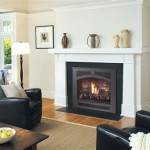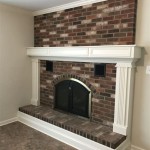Rustic Wood Mantels For Stone Fireplaces: A Guide to Material Selection, Design Integration, and Installation
The convergence of rustic wood mantels and stone fireplaces epitomizes a design aesthetic that blends natural textures, warmth, and enduring appeal. This architectural combination provides both visual interest and functional utility, making it a popular choice for homeowners seeking to enhance the ambiance of their living spaces. The integration of a rustic wood mantel with a stone fireplace requires careful consideration of material selection, design principles, and installation techniques to ensure a cohesive and aesthetically pleasing outcome.
The selection of the appropriate wood and stone materials is the foundational step in achieving a successful design. The characteristics of the wood, including its species, grain, color, and texture, must complement the type, color, and arrangement of the stonework. Understanding these factors is critical for creating a harmonious and visually balanced fireplace feature.
Material Selection: Wood Species and Stone Types
The choice of wood for a rustic mantel is a crucial decision that influences the overall aesthetic and durability of the fireplace. Several wood species are commonly used for rustic mantels, each offering unique characteristics: reclaimed wood, cedar, oak, pine, and walnut. Reclaimed wood, sourced from old barns, buildings, or industrial structures, offers a unique character with its weathered appearance, nail holes, and saw marks. It carries a historical narrative and contributes to a sense of sustainability. Cedar is prized for its natural resistance to decay, insects, and moisture, making it an excellent choice for both indoor and outdoor applications. Its distinctive aroma and rich color variations add to its appeal. Oak, known for its strength, durability, and prominent grain patterns, is a classic choice for rustic mantels. It can be stained to achieve a wide range of colors, allowing for versatility in design integration. Pine, a softer and more affordable option, is often used for rustic mantels due to its knotty texture and ability to accept stains and paints well. It is a suitable choice for achieving a lighter and more casual aesthetic. Walnut, a hardwood with a rich, dark color and fine grain, lends an air of sophistication and elegance to rustic mantels. Its natural beauty is often enhanced with a clear finish to showcase its inherent characteristics.
The selection of stone for the fireplace is equally important and should complement the wood species chosen for the mantel. Common stone types include fieldstone, river rock, stacked stone, and ledgestone. Fieldstone, characterized by its irregular shapes, sizes, and colors, provides a rustic and natural appearance. It is often sourced locally, adding to the sense of regional authenticity. River rock, smooth and rounded due to the erosion of water, offers a softer and more organic aesthetic. Its varied colors and textures create a visually appealing surface. Stacked stone, composed of thin, rectangular pieces of stone arranged horizontally, provides a clean and contemporary take on traditional stonework. It is available in a variety of colors and textures, allowing for customization to suit different design styles. Ledgestone, similar to stacked stone but with a more pronounced texture and irregular edges, offers a more rugged and natural appearance. It is often used to create a bold and visually striking fireplace feature.
Considerations when selecting stone and wood include the overall color palette of the room, the desired style (e.g., farmhouse, contemporary rustic, traditional), and the structural integrity of the fireplace and mantel. The color of the stone should either complement or contrast with the wood, depending on the desired effect. The style of the stone and wood should be consistent with the overall design of the room. The weight of the stone and wood must be considered to ensure that the fireplace and mantel can support the load. A structural engineer or experienced contractor should be consulted to assess the structural requirements and ensure that the installation is safe and sound.
Design Integration: Size, Proportion, and Style Considerations
The successful integration of a rustic wood mantel with a stone fireplace requires careful consideration of size, proportion, and style. The size of the mantel should be proportional to the size of the fireplace and the surrounding wall. A mantel that is too small will appear insignificant, while a mantel that is too large will overwhelm the fireplace. The proportion of the mantel's depth to its height is also important. A mantel that is too deep will protrude excessively, while a mantel that is too shallow will lack visual impact.
The style of the mantel should complement the style of the fireplace and the overall design of the room. A rustic mantel with a rough-hewn texture and exposed knots will pair well with a fieldstone fireplace, while a more refined mantel with a smooth finish and clean lines will be better suited for a stacked stone fireplace. The style of the mantel should also be consistent with the overall design of the room. For example, a rustic mantel would be a natural fit for a farmhouse-style living room, while a more contemporary mantel would be more appropriate for a modern living room.
Consider the mantel's placement in relation to the fireplace opening and any surrounding architectural elements. The mantel should be positioned at a comfortable height for displaying decorative items and should not obstruct the view of the fire. Typically, mantels are installed 12 inches or more above the fireplace opening. The mantel should also be aligned with any surrounding architectural features, such as windows or built-in shelves. The use of corbels or other decorative supports can add visual interest and reinforce the rustic aesthetic. The finish of the mantel should also be carefully considered. A clear finish will showcase the natural beauty of the wood, while a stain will add color and depth. The finish should be durable and resistant to heat and moisture.
The design integration process also encompasses the surrounding elements. Consider the hearth, which is the non-combustible area at the base of the fireplace. The hearth should be large enough to protect the flooring from sparks and embers and should be made of a material that complements the stone and wood. Consider the wall above the fireplace, which can be painted, wallpapered, or clad with stone or tile. The wall above the fireplace should be visually balanced with the fireplace and the mantel. Consider the decorative items that will be displayed on the mantel. These items should be carefully selected to complement the style of the fireplace and the mantel. Avoid clutter and focus on displaying a few carefully chosen pieces.
Installation Techniques: Ensuring Structural Integrity and Safety
The proper installation of a rustic wood mantel onto a stone fireplace is crucial for ensuring structural integrity and safety. The weight of the mantel and the type of stone fireplace will determine the appropriate installation method. Generally, there are two primary methods for attaching a mantel to a stone fireplace: using a ledger board or directly securing the mantel to the stone.
The ledger board method involves attaching a wooden board to the stone fireplace using masonry screws or anchors. The mantel is then attached to the ledger board using screws or nails. This method is suitable for lighter mantels and fireplaces where the stone is relatively soft and easy to drill into. The ledger board distributes the weight of the mantel evenly across the stone, reducing the risk of cracking or damage. Before attaching the ledger board, ensure that it is level and properly aligned. Use a level and a tape measure to mark the location of the ledger board on the stone fireplace. Drill pilot holes through the ledger board and into the stone fireplace. Insert masonry screws or anchors into the pilot holes and tighten them securely. Attach the mantel to the ledger board using screws or nails. Ensure that the screws or nails are long enough to penetrate the ledger board and the mantel securely.
Directly securing the mantel to the stone involves drilling holes directly into the stone fireplace and inserting anchors or bolts. The mantel is then attached to the anchors or bolts. This method is suitable for heavier mantels and fireplaces where the stone is hard and durable. A professional installer is highly recommended for this method, as it requires specialized tools and expertise. Use a masonry drill bit to drill holes into the stone fireplace. The size and depth of the holes will depend on the size and type of anchors or bolts being used. Insert the anchors or bolts into the holes and tighten them securely. Attach the mantel to the anchors or bolts. Ensure that the anchors or bolts are strong enough to support the weight of the mantel.
Regardless of the chosen method, several crucial steps must be followed to ensure a safe and structurally sound installation. Always consult local building codes and regulations to ensure compliance. Prior to installation, carefully inspect the stone fireplace for any cracks or damage. If any damage is found, repair it before proceeding with the installation. Use appropriate safety gear, including safety glasses, gloves, and a dust mask. Work with a helper to lift and position the mantel. Ensure that the mantel is level and properly aligned before securing it. Double-check all connections and fastenings to ensure that they are secure. Allow sufficient clearance between the mantel and the fireplace opening to prevent heat damage. A minimum clearance of 12 inches is generally recommended. If the fireplace is wood-burning, ensure that the mantel is made of a non-combustible material or is protected by a heat shield. After installation, inspect the mantel regularly for any signs of movement or damage. If any problems are detected, address them promptly. By following these guidelines, homeowners can successfully integrate a rustic wood mantel with a stone fireplace, creating a beautiful and functional focal point for their living space.

Distinctive Rustic Fireplace Mantel With Legs And Inside Farmhouse Remodel Home

Barnwood Fireplace Mantel The Collection

Distinctive Rustic Fireplace Mantel With Legs And Inside Corners Personalize Your Choice Of Color Size Mantels Home Wood

Custom Fireplace Mantels Bluffton A Wood Mantel You Ll Love Studabaker Specialty Woodworks

Rustic Mantel 6h X 8d Fireplace Mantle Shelf Reclaim Wood Barn Reclaimed Beam Decor

Elements Of Style Solutions Awkward Outdated Fireplaces

Magrahearth Rustic Barn Wood Concrete Mantel Fireplace Stone Patio

Rustic Wood Fireplace Mantels Log Mantles Best Of Nature

Rustic Fireplace Mantels Mantel Littlebranch Farm

Mantel Barn Beam Wooden 7 X 9 Rough Hewn Fireplace Rustic Wood
Related Posts








